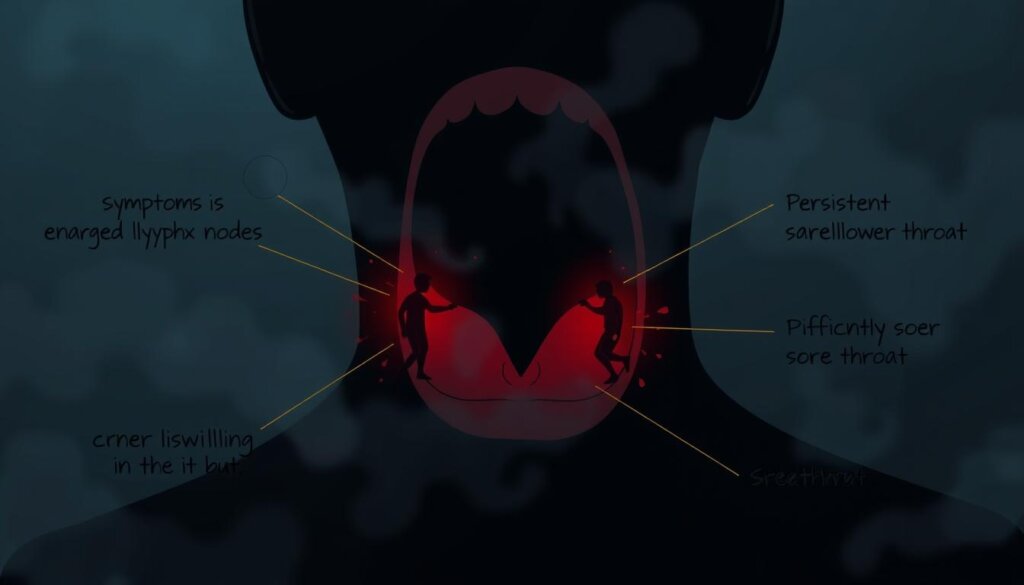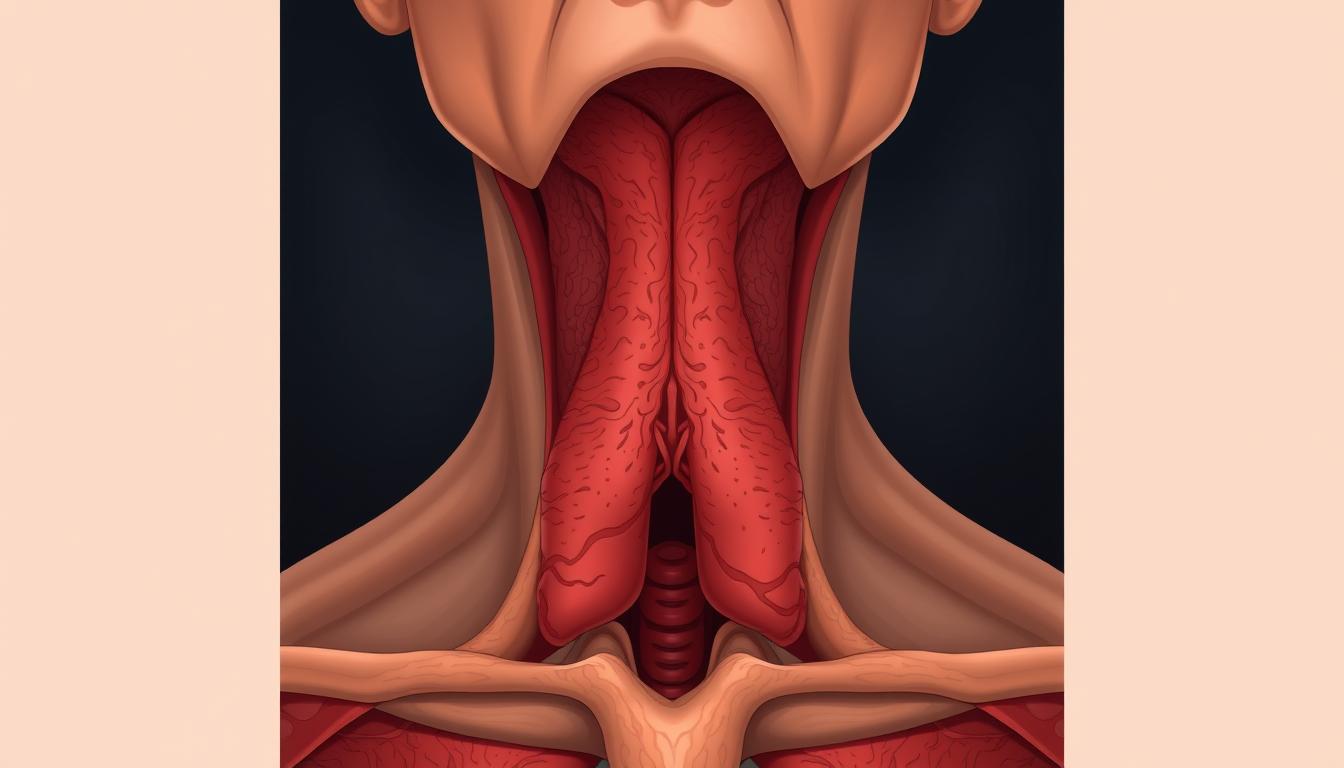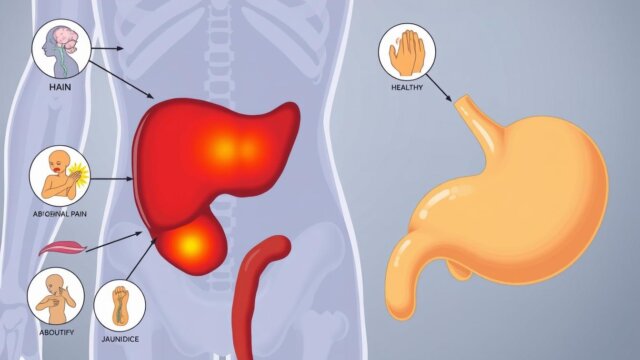FTC disclaimer: This post may contains affiliate links and we will be compensated if you click on a link and make a purchase.
Hypopharyngeal cancer is a rare head and neck cancer. It makes up only 3% of all cancer cases in the United States each year. This cancer starts in the squamous cells of the lower throat, behind the voice box. It often shows symptoms that seem harmless but can be serious if ignored.
It’s important to know about hypopharyngeal cancer’s causes, symptoms, and treatments. This knowledge helps catch the disease early. It also improves how well patients do. This article will help you understand this complex disease better.
Key Takeaways:
- Hypopharyngeal cancer is a rare type of head and neck cancer that forms in the lower throat behind the voice box.
- Smoking, heavy alcohol use, and poor diet are major risk factors for developing this cancer.
- Common symptoms include persistent sore throat, ear pain, difficulty swallowing, and changes in voice.
- Diagnostic tests like endoscopy, imaging scans, and biopsy are used to confirm the diagnosis.
- Treatment options include surgery, radiation therapy, chemotherapy, and immunotherapy, depending on the cancer stage.
What is Hypopharyngeal Cancer?
Defining Hypopharyngeal Cancer
Hypopharyngeal cancer is a rare head and neck cancer. It starts in the hypopharynx, the lower part of the throat. This cancer grows from bad cells in the hypopharynx tissues.
Location of the Hypopharynx
The pharynx is a tube behind the nose and mouth. It goes down the neck and meets the esophagus and trachea. The hypopharynx is at the bottom, near the esophagus and voice box. Most cancers here start in the squamous cells lining the hypopharynx.
Hypopharyngeal Cancer Characteristics | Key Details |
|---|---|
Cancer Type | Squamous cell carcinoma |
Location | Lower part of the pharynx (throat), just above the esophagus and larynx |
Prevalence | Rare type of head and neck cancer |
“Hypopharyngeal cancer is a disease in which malignant (cancer) cells form in the tissues of the hypopharynx, the bottom part of the pharynx (throat).”
Causes and Risk Factors
Hypopharyngeal cancer is a type of head and neck cancer. It has several risk factors. Tobacco use and too much alcohol are the main causes.
Smoking, whether in cigarettes, cigars, or chewing tobacco, raises the risk. Drinking a lot of alcohol also increases the chance of getting this cancer.
Other factors can also lead to hypopharyngeal cancer. Eating poorly, lacking in vitamins and minerals, can be a risk. People with Plummer-Vinson syndrome, a rare genetic disorder, are more likely to get this cancer.
Tobacco and Alcohol Use
The more you smoke or drink, the higher your risk. Using both tobacco and alcohol together raises the risk even more.
Other Risk Factors
Being male or older can also increase your risk. Some racial and ethnic groups may be more likely to get it, but the reasons are not clear.
While these factors can raise your risk, they don’t mean you’ll definitely get cancer. Regular check-ups and preventive measures can help lower your risk.
“Hypopharyngeal cancer is a rare and aggressive type of head and neck cancer, and understanding the risk factors is crucial for prevention and early intervention.”
Symptoms of Hypopharyngeal Cancer
Hypopharyngeal cancer is a rare head and neck cancer. It often doesn’t show symptoms early on. But, as it grows, people might notice a sore throat, ear pain, trouble swallowing, voice changes, and a neck lump.
A sore throat that won’t go away is a common sign. It can feel uncomfortable or painful when swallowing, known as dysphagia. Voice changes, like hoarseness or a raspy voice, also happen as the tumor affects the larynx and vocal cords.
A lump or mass in the neck is another key sign. This usually happens when cancer spreads to lymph nodes, affecting up to 50% of cases. Some people might also feel ear pain due to the tumor in the hypopharynx.
These symptoms can mean different things, not just hypopharyngeal cancer. If you notice any, seeing a doctor right away is key for a correct diagnosis and treatment.

“The mortality and morbidity rates are higher in patients with significant weight loss, comorbidity, or poor performance indicators.”
Spotting and treating hypopharyngeal cancer early is vital for better outcomes. If you or someone you know has these symptoms get a doctor’s check-up without delay.
Diagnosis and Tests
Doctors use many tests to find hypopharyngeal cancer. First, they do a physical exam to look for signs of cancer in the head and neck. They check for swollen lymph nodes. Then, they might do an indirect laryngoscopy to look at the throat in the office. This takes just 5 to 10 minutes.
For a closer look, they might use a direct flexible laryngoscopy. This uses a tube through the nose to see the larynx. It takes about 10 minutes in the office. Sometimes, they do a direct rigid laryngoscopy in an operating room. This lets them take tissue samples for tests.
They also check other parts of the head and neck for cancer. This is because people with this cancer are more likely to get other cancers. They do a panendoscopy to look at the whole area. This is done in an operating room under general anesthesia.
To confirm the diagnosis, they take a biopsy. This means taking a small tissue sample from the suspected area for lab tests. They can do this through endoscopic biopsy or fine-needle aspiration (FNA) biopsy. The samples are then checked closely, and more tests might be done.
Imaging tests are also key in diagnosing and monitoring hypopharyngeal cancer. They include CT scans, MRI scans, chest x-rays, PET scans, bone scans, and barium swallow tests. These help find where and how far the cancer has spread. This is important for choosing the right treatment.
Before starting treatment, they might do blood tests to check the patient’s health. They also tell patients to stop smoking. This can help the treatment work better and avoid problems.

Diagnostic Test | Purpose |
|---|---|
Physical Exam | To check for signs of possible cancer in the head and neck area, such as swollen lymph nodes. |
Indirect Laryngoscopy | A simple procedure to examine the throat takes 5 to 10 minutes in the doctor’s office. |
Direct Flexible Laryngoscopy | Using a fiber-optic tube inserted through the nose to examine the larynx and nearby areas, taking about 10 minutes in the doctor’s office. |
Direct Rigid Laryngoscopy | A comprehensive throat examination is performed in an operating room under general anesthesia, allowing for tissue sample extraction. |
Panendoscopy | Combining laryngoscopy, esophagoscopy, and bronchoscopy to examine the entire region around the larynx and hypopharynx, often conducted in an operating room under general anesthesia. |
Biopsy | Obtaining tissue samples from suspected cancerous areas, such as through endoscopic biopsy or fine-needle aspiration (FNA) biopsy, for laboratory analysis. |
Imaging Tests | CT scans, MRI scans, chest x-rays, PET scans, bone scans, and barium swallow tests used to identify the location and stage of the cancer. |
Blood Tests | Performed before initiating treatments like surgery or chemotherapy to assess the patient’s overall health. |
Diagnosing hypopharyngeal cancer involves many tests and exams. Doctors use these to find where and how far the cancer has spread. This helps them choose the best treatment for each patient.
Staging of Hypopharyngeal Cancer
When you get diagnosed with hypopharyngeal cancer, more tests are done to find out the stage. The staging process looks at the tumor size if it has spread to nearby lymph nodes, and if it has gone to other parts of the body. This info is key for making a treatment plan and knowing how the cancer is progressing.
The American Joint Committee on Cancer (AJCC) TNM system is used for staging hypopharyngeal cancer. The stages go from 0 (early) to IV (advanced). Higher stages mean the cancer is more serious and might need more treatment. Knowing the tumor size, how far it has spread, and if it’s touching nearby structures is important for treatment plans and predicting outcomes.
Stage 0 (TisN0M0) means the tumor is in the top layer of cells in the hypopharynx and hasn’t grown deeper. It hasn’t spread to lymph nodes or distant parts of the body. Stage I (T1N0M0) shows the tumor has grown deeper but is still in one part of the hypopharynx. It’s no more than 2 centimeters across, with no spread to lymph nodes or distant sites.
Stage II (T2N0M0) means the tumor has grown into more than one part of the hypopharynx. It’s larger than 2 cm but no more than 4 cm across. It hasn’t affected the vocal cords, and there’s no spread to lymph nodes or distant areas.
Stage III (T3N0M0) shows a tumor bigger than 4 cm across. It impacts vocal cords or grows into the esophagus. There’s no spread to lymph nodes or distant sites or tumors T1-T3N1M0 with a single lymph node on the same side as the tumor.
Stage IVA and IVB are more advanced stages with varying tumor sizes and lymph node involvement. They show the cancer has spread within the hypopharynx and nearby structures. Stage IVC is the most advanced, showing cancer spread to distant parts of the body (M1), while the main tumor can be any size, and lymph node involvement varies.
Stage | Tumor Size (T) | Lymph Node Involvement (N) | Metastasis (M) |
|---|---|---|---|
0 | Tis | N0 | M0 |
I | T1 | N0 | M0 |
II | T2 | N0 | M0 |
III | T3, T1-T3 | N0, N1 | M0 |
IVA | T4a | N0-N1 | M0 |
IVB | T4b | Any N | M0 |
IVC | Any T | Any N | M1 |
Categories like TX and NX mean the main tumor or lymph nodes can’t be checked because of missing info. It’s important to remember that actual stats depend on the patient’s own situation and can change based on their case.
“The staging system for hypopharyngeal cancer follows the TNM system, which assesses the size of the primary tumor (T), whether the cancer has spread to lymph nodes (N), and if it has metastasized to other organs (M).”
Knowing the stage of hypopharyngeal cancer is key for picking the right treatment and guessing the patient’s outcome. The detailed staging info helps doctors create a treatment plan that fits the cancer’s specific traits.
Treatment Options
People with hypopharyngeal cancer have many treatment choices. These include surgery, radiation therapy, and chemotherapy. They might use one or more of these options.
Surgery
Surgery for hypopharyngeal cancer can remove part or all of the larynx and/or hypopharynx. This might include laryngectomy, pharyngectomy, or laryngopharyngectomy. The right surgery depends on the tumor’s stage and location, and the patient’s health.
Radiation Therapy
Radiation therapy is a common choice for hypopharyngeal cancer. It can be used alone or with other treatments. Radiation can target the tumor and nearby lymph nodes.
It’s especially effective for early-stage cancers when used with chemotherapy.
Chemotherapy
Chemotherapy is another option for treating hypopharyngeal cancer. It can be used alone or with other treatments. Chemotherapy can be given before or with radiation therapy.
In some cases, it’s recommended for advanced or recurring cancers.
Patients might also join clinical trials for new cancer treatments. These trials offer access to new treatments and help improve cancer care.
Treatment Approach | Potential Benefits | Considerations |
|---|---|---|
Surgery | – Removes the tumor and affected lymph nodes – May save organ function (e.g., larynx) | – Surgery risks – May affect speech and swallowing |
Radiation Therapy | – Non-invasive – Works well for early-stage cancers – Can be used with other treatments | – Side effects (e.g., skin irritation, swallowing trouble) – Not good for advanced or recurring cancers |
Chemotherapy | – Shrinks tumors before other treatments – Good for advanced or recurring cancers | – Side effects (e.g., nausea, fatigue, low blood counts) – Often used with other treatments |
The right treatment for hypopharyngeal cancer depends on many things. These include the tumor’s stage and location, the patient’s health, and their preferences. A team of doctors, including oncologists, surgeons, and radiation therapists, will choose the best treatment plan for each patient.
Hypopharyngeal Cancer
Hypopharyngeal cancer is a rare head and neck cancer. It starts in the hypopharynx, the lower throat. It’s not common, making up only 3% of head and neck cancers in the US. Most cases are squamous cell carcinoma, about 95%.
This cancer is serious because it can spread easily. It’s near big lymphatic vessels. Hypopharyngeal cancer has a high death rate because it’s hard to catch early. Only 2,500 cases are seen in the US each year.
The cancer’s outlook depends on its stage at diagnosis. Stage I has a 41% five-year survival rate. Stages II and III have a 36% rate. Sadly, Stage IV has a 10% survival rate, often found in the end stage.
Treatment includes chemotherapy, radiation, and surgery. Neoadjuvant chemotherapy before surgery and radiation works best for Stages III and IV.
Those with hypopharyngeal cancer are at risk for more cancers. They need careful follow-up. Early detection and treatment are key for better outcomes and quality of life.
Hypopharyngeal Cancer Stage | 5-Year Survival Rate |
|---|---|
Stage I | 41% |
Stage II and III | 36% |
Stage IV | 10% |
“Hypopharyngeal cancer is a rare and aggressive form of head and neck cancer that requires prompt and comprehensive treatment for the best possible outcomes.”
In summary, hypopharyngeal cancer is rare and tough. It needs early detection and a mix of treatments. Learning about causes, symptoms, and treatments is key. With new research and care, patients’ chances are getting better.
Prognosis and Survival Rates
The outlook for hypopharyngeal cancer depends on several things. These include the cancer’s stage, the patient’s age, and their health.
The 5-year survival rate for hypopharyngeal cancer is about 37% overall. But, this number changes a lot based on cancer’s stage. For cancer that’s just in one place, the survival rate is 61%. For cancer that has spread, it’s 39%. And for cancer that has gone far away, it’s 28%.
Factors Affecting Prognosis
Other things like the patient’s age and health also play a big role. Older patients and those with other health issues might have a worse outlook.
Remember, these survival rates are for when the cancer is first found. They might not be the same if the cancer gets worse or comes back after treatment.
“The worst survival rates were observed in patients with hypopharyngeal carcinoma in the posterior wall of the hypopharynx.”
It’s very important for patients to talk to their doctors about their own situation. Going for regular check-ups and following treatment plans can make a big difference for those with hypopharyngeal cancer.
Prevention and Risk Reduction
To lower your chance of getting hypopharyngeal cancer, there are a few key steps. First, stay away from tobacco products. Tobacco use is a big risk factor. People who smoke have a 4 to 5 times higher risk of getting oral, oropharyngeal, and hypopharyngeal cancers. They also have a 10 times higher risk of laryngeal cancer than non-smokers.
Quitting smoking can greatly lower your risk. Stopping tobacco use cuts the risk of oral, oropharyngeal, hypopharyngeal, and laryngeal cancers.
Also, drink alcohol in moderation. Drinking too much alcohol raises the risk of head and neck cancers. Heavy drinkers have a 2 to 6 times higher risk than those who don’t drink at all. Smoking and drinking together increases the risk even more. Heavy smokers and drinkers have a 5 to 14 times higher risk.
Eating a healthy, balanced diet with lots of fruits and vegetables can also help. Getting the HPV vaccine can prevent some cases of hypopharyngeal cancer. HPV-16 infection greatly increases the risk of oropharyngeal cancer. The HPV vaccine can prevent about 90% of oral HPV-16/HPV-18 infections in 4 years.
Risk Factor | Increased Risk |
|---|---|
Tobacco Use | 4-5 times for oral cavity, oropharyngeal, and hypopharyngeal cancers 10 times for laryngeal cancer |
Alcohol Consumption | 2-6 times for heavy drinkers compared to non-drinkers |
Combined Tobacco and Alcohol Use | 5-14 times for heavy smokers and drinkers |
HPV-16 Infection | 15-fold increase in oropharyngeal cancer risk |
By avoiding tobacco, drinking less alcohol, and living a healthy lifestyle, you can lower your risk of hypopharyngeal cancer.
Conclusion
Hypopharyngeal cancer is a rare but serious throat cancer. It has unique challenges in early detection, treatment, and long-term outlook. The survival rates vary worldwide, especially for advanced cancers and those linked to heavy smoking.
Understanding the role of human papillomavirus (HPV) and other risk factors is key. This includes occupational exposures. It’s important for better prevention and management.
Regular check-ups and quick action on symptoms like swallowing trouble or sore throat are vital. They can lead to early diagnosis and treatment success. Also, tackling risk factors like tobacco and alcohol use can lower cancer rates.
By working with healthcare and staying proactive about health, we can lessen risks. This improves our chances of good outcomes.
Research is key to understanding hypopharyngeal cancer better. We must stay alert and push for more research in early detection and treatments. Together, we can improve lives and outcomes for those with this disease.
FAQ
What is hypopharyngeal cancer?
Hypopharyngeal cancer is a rare cancer in the lower throat. It’s behind the voice box. It starts in the hypopharynx, the bottom part of the throat.
What are the main risk factors for hypopharyngeal cancer?
Main risks include smoking, chewing tobacco, and drinking too much alcohol. A diet lacking nutrients and Plummer-Vinson syndrome also increase risk.
What are the common symptoms of hypopharyngeal cancer?
Symptoms include a sore throat, ear pain, and trouble swallowing. You might notice voice changes, a neck lump, or feel tired and lose weight. But, it often doesn’t show symptoms until it’s advanced.
How is hypopharyngeal cancer diagnosed?
Doctors use tests like physical exams, CT scans, and PET scans. A biopsy confirms it. An endoscopy might also be used to look at the throat.
How is hypopharyngeal cancer staged?
Staging looks at the tumor size, if it’s spread, and how far it’s gone. Stages range from 0 (early) to IV (advanced).
What are the treatment options for hypopharyngeal cancer?
Treatments include surgery, radiation, and chemotherapy. Doctors might use a mix of these.
What is the prognosis for hypopharyngeal cancer?
Survival rates depend on the cancer stage, age, and health. The 5-year survival rate is about 37%. But, it varies a lot based on the stage.
How can I reduce my risk of developing hypopharyngeal cancer?
Avoid tobacco, drink less alcohol, and eat healthy foods. Quitting smoking and drinking less can really help.








